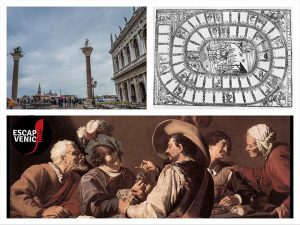
900 YEARS OF GAMBLING: FROM THE SERENISSIMA TO THE PRESENT DAY
“La matina una messeta, dopo pranzo una basseta e la sera una doneta” (in the morning a mass, after lunch a game and in the evening a woman) said one of the most popular Venetian proverbs of the 18th century.
Venice of the Serenissima was the capital of world trade, comparable to today’s Wall Street (as we have already written in a post) but also of the game and comparable to Las Vegas that we know today. It was a volcanic city, incredible, in continuous ferment.
There is a curious episode between history and legend that dates back as far as 1172 the first public gaming house, or rather gaming square. The Venetians, after yet another clash in the East, returned to the Lagoon with three columns as spoils of war. One of them ended up in the water and was never found again. The other two remained in Piazza San Marco for a long time because no one could lift them vertically. An edict was issued and finally a certain Niccolò Barattieri, architect and engineer, managed to lift them: still today they support the winged lion of the Evangelist and San Teodoro. In exchange Barattieri obtained from the Doge Sebastiano Ziani to be able to organize any game in the space between the two columns and on their steps. A few years later the first repressive laws were issued: the corporal and pecuniary punishments provided for were terrible (sedan, lashes, cutting of the nose or ears …), but nothing managed to defeat in the nobles and in the people the desire to risk their money with dice, cards or lotteries. A real gambling fever. But what was the game about? At a bit of everything, the important thing was to play and bet.
As indicated in Pier Alvie Zorzi’s latest book “From San Marco to Sant’Elena, il cuore del mondo” in 1254 the game in the atrium of San Marco was forbidden, and this makes you understand how much the game had taken the Venetians who even played at the church entrance and a few years later also inside the church! In 1292 they tried to forbid it everywhere (only chess and board games were allowed)!
They all risked their money: nobles, priests, monks, Jews, vagrants, criminals and strangers. So the Serenissima decided to open a public casino, managed directly by the government with strict rules, even set by the Council of Ten. It was the first authorized casino in the world: it was the Ridotto Grande, in Calle Vallaresso, where today stands the Hotel Monaco. The croupiers were nobles who had fallen into disrepair; one could only enter and play with one’s face in disguise; the house was opened at Carnival, which in any case lasted almost six months in Venice (from October onwards).
Inside the Casino, in addition to the game, you could find “company” but also discuss, read poetry, play or listen to an instrument. The greatest development of gambling was in the seventeenth and eighteenth centuries, so much so that in the mid-eighteenth century in Venice there were 118 Casinos. And the tradition has not been set aside, since 1938 Venice is the only Italian city to have a Casino managed by ‘municipal administration.
References:
https://ricerca.repubblica.it/repubblica/archivio/repubblica/1989/01/14/sei-secoli-azzardo-nella-serenissima.html
Pier Alvise Zorzi- Pierfranco Fabris “VENEZIA – Da San Marco a Sant’Elena, il Cuore del Mondo”
